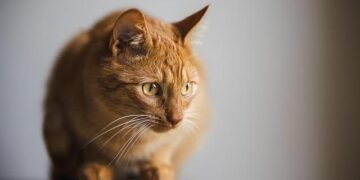Table of Contents
Byline: Alex Carter, Feline Behavior & Enrichment Specialist
I’ve been a cat person my entire life, but nothing prepared me for Leo.
A sleek, silver tabby with an Olympian’s grace and a hunter’s soul, he was the perfect companion in every way but one.
The morning “gifts” started a few weeks after I adopted him.
First, it was a field mouse, which was startling enough.
But then came the birds.
Finding a small, still songbird on my doormat was a uniquely heartbreaking experience.
It created a knot of conflict in my stomach: a deep, unwavering love for my cat, tangled with a profound sense of guilt and responsibility for the local wildlife we’re meant to be stewards of.
Like so many cat owners trapped in this dilemma, I reached for the most common and intuitive fix: a collar with a small, silver bell.
The gentle jingle as Leo moved around the house became a sound of hope.
I imagined it as a tiny alarm system, a fair warning to any creature in his path.
This, I thought, was the responsible solution, the simple compromise that would allow my cat his cherished outdoor freedom while protecting the birds in our garden.
For a while, the jingle brought a fragile peace of mind.
But I was wrong.
I was treating a complex ecological problem with a folk remedy, and the truth would arrive in the most devastating way possible.
The Jingle of Deceit: When the “Solution” Fails
The breaking point came on a bright May morning.
There, on the welcome mat, was a goldfinch, its vibrant yellow feathers a stark and tragic contrast to the gray stone.
Leo sat nearby, purring, oblivious to my dismay.
The bell on his collar was silent.
In that moment, I realized the bell wasn’t just ineffective; it was a deception.
It had lulled me into a false sense of security while the body count continued to rise.
That failure sent me down a rabbit hole of research, and what I found was a landscape of confusing and contradictory evidence.
Some studies, like one from the UK, suggested a bell could reduce bird predation by 41% and mammal predation by 34%.1
Another from New Zealand found a 50% reduction in birds caught.2
On the surface, that sounds promising, but it still means the bell fails half the time.
Worse, other studies, particularly one in Australia, found no significant effect at all.1
The science was a mess, offering no clear answer, only more uncertainty.
I began to understand why.
The common wisdom is that clever cats simply learn to stalk silently, keeping the bell from ringing until the final, explosive pounce.3
This is partially true, but the reality is more nuanced.
Cats are primarily ambush predators; much of their hunting involves sitting perfectly still, waiting for the right moment.
During this critical period of stealth, a movement-based alarm like a bell is utterly useless.4
Furthermore, in a suburban environment filled with wind chimes and other noises, prey animals can become habituated to the sound, no longer registering the jingle as a specific threat.5
The problem wasn’t that my cat was too clever; the problem was that the bell was too simple.
It was a single, crude auditory signal in a complex, multi-sensory battle between predator and prey.
Of course, I also had to address the nagging worry shared by many owners: was the constant jingling harmful to Leo? Thankfully, the evidence here is much clearer.
A typical cat collar bell produces a sound of around 50-60 decibels (dB).
Studies show that cat hearing is generally unaffected by sounds below 80 dB, making the bell more of a minor annoyance than a genuine danger to their auditory health.6
While a particularly anxious cat might find it stressful, for most cats, the bell itself is not physically harmful.8
This was a relief, but it didn’t solve the core issue.
The bell was a failed strategy.
I needed a new way to think about the entire problem.
An Epiphany from Unlikely Sources: Warships and Wasps
Frustrated, I stepped away from veterinary journals and found my answer in the most unexpected places: military history and evolutionary biology.
One evening, I was reading about naval tactics in World War I and came across the story of “Dazzle” camouflage.
During the war, the British Admiralty faced a deadly problem: German U-boats were sinking Allied ships at an alarming rate.
The initial response was to try to camouflage the ships to make them invisible, but hiding a 10,000-ton vessel on the open ocean is practically impossible.
A marine artist named Norman Wilkinson proposed a radical idea.
Instead of trying to hide the ships, he would make them more conspicuous.
He used bold, jarring, high-contrast geometric patterns—stripes, curves, and clashing colors—to break up the ship’s form.
The goal wasn’t concealment; it was confusion.
A U-boat commander looking through a periscope wouldn’t be able to accurately judge the dazzle ship’s size, speed, range, or heading, making it incredibly difficult to calculate a successful torpedo strike.9
This was my first epiphany.
The goal shouldn’t be to try and make my cat invisible or silent—that fights his very nature.
The goal should be to disrupt the prey’s ability to process him as a target.
It’s not about stealth; it’s about scrambling the signal.
This new line of thinking led me to the concept of aposematism.
In nature, many animals don’t hide; they advertise.
Think of the brilliant yellow and black stripes of a wasp, the vivid colors of a poison dart frog, or the sharp black-and-white pattern of a skunk.11
This is aposematism: using a conspicuous signal to send an honest, unmistakable warning to predators that says, “I am dangerous, unpalatable, or otherwise not worth attacking.”.13
This warning isn’t just visual; it’s often multi-modal, combining color with sound (a rattlesnake’s rattle), odor (a skunk’s spray), or behavior (a cobra’s hood) to create a message that is impossible to ignore.12
The two concepts clicked together into a powerful new framework.
The bell had failed because it was a weak, single-channel signal.
The true solution wasn’t to try and cancel my cat’s predatory nature but to give him an “honest signal” that loudly and clearly communicates his predatory intent to potential victims in a language they are biologically wired to understand.
I needed to stop trying to interrupt his stealth and start focusing on Threat Communication.
The “Threat Communication” Toolkit: A New Strategy for Cat Guardians
Armed with this new paradigm, I re-evaluated the tools available to responsible cat owners.
The goal was no longer just to “put something on the cat,” but to choose the right tool to send the clearest message through the most effective sensory channel for the specific prey at risk.
Channel 1: Auditory Warning (The Bell, Re-examined)
Viewed through this new lens, the bell is a form of “acoustic aposematism.” It attempts to communicate threat through sound.
However, as my experience and the research showed, it is a fundamentally weak and unreliable channel.
It’s a single-mode signal that is easily defeated by a cat’s ambush hunting style and can be tuned out by prey in noisy environments.4
It is the least effective form of threat communication available.
Channel 2: Visual Disruption & Warning (The “Dazzle” Collars)
This is where the principles of Dazzle camouflage and aposematism come to life.
The most prominent example is the BirdsBeSafe® collar cover, a wide, brightly colored fabric tube that fits over a cat’s collar.14
This device works because songbirds have exceptional color vision, thanks to unique anatomical structures in their eyes.15
The bright, contrasting colors of the collar cover make the cat hyper-visible to birds, acting as both a Dazzle pattern that breaks up the cat’s familiar shape and an aposematic warning signal of danger.
The evidence for this visual channel is compelling.
Scientific studies have shown it to be remarkably effective, with some reporting a reduction in birds caught by as much as 87%.15
Other field studies confirm significant decreases, with one U.S. study showing a 61% reduction in birds brought home and an Australian study showing a 54% reduction in all color-sensitive prey.14
For protecting birds, this visual “threat communication” is vastly superior to the auditory channel of a bell.
Its primary limitation, however, is that it relies on color vision, making it minimally effective for protecting mammals, which do not perceive color as vividly.16
Channel 3: Physical & Biomechanical Interference (The Bib)
The CatBib™ operates on a different channel entirely.
It communicates threat not at a distance, but at the last possible moment by physically interfering with the hunt.
The bib is a lightweight neoprene flap that hangs down from the collar over the cat’s chest.
When the cat pounces, the bib gets in the way, acting as a physical barrier that disrupts the biomechanics of the kill.17
Research has shown the CatBib to be highly effective.
One major study found it stopped 81% of collared cats from catching birds.17
Crucially, it was also moderately effective for mammals, reducing their predation by 45%.19
This makes the bib a more versatile, multi-species tool than the BirdsBeSafe collar.
Interestingly, studies on both the CatBib and colorful collars found that adding a bell conferred no extra statistical benefit.19
This powerfully reinforces the new paradigm: success comes from choosing the
strongest, most appropriate channel, not from simply adding more noise.
The Guardian’s Guide: A Strategic Comparison
My journey taught me that being a responsible cat guardian isn’t about finding a single “magic bullet.” It’s about becoming a strategist.
It requires you to assess your cat’s specific hunting behavior, identify the primary prey in your area, and choose the device that communicates threat most effectively to that prey.
To make this strategic choice easier, I’ve distilled my research into a simple comparison table.
This tool allows you to move beyond guesswork and make an evidence-based decision that best fits your situation.
| Device | Primary Mechanism (Threat Channel) | Bird Predation Reduction | Mammal Predation Reduction | Best For… | Key Limitations |
| Bell Collar | Auditory Warning | ~41-50% 1 | ~34% 1 | Owners seeking a minimal, low-cost intervention. | Highly inconsistent results; easily defeated by ambush hunting; potential for prey habituation. |
| BirdsBeSafe® Collar | Visual Warning (Aposematism/Dazzle) | Up to 87% 15 | Minimal / Not significant 16 | Protecting songbirds in areas where they are the primary prey. | Ineffective for mammals and potentially some non-songbird species with different visual perception. |
| CatBib™ | Physical/Biomechanical Disruption | ~81% 17 | ~45% 19 | All-around protection when both birds and small mammals are at risk. | Can look unusual; slightly lower bird protection rate than BirdsBeSafe®. |
When introducing any of these devices, always use them with a modern breakaway collar, which is designed to release under pressure if the cat gets snagged, ensuring their safety.6
The Ultimate Peace of Mind: The “Catio” Gold Standard
While these tools are powerful harm-reduction strategies, they are not foolproof.
The most effective “threat communication” of all is an impenetrable barrier.
If the goal is 100% prevention, there is only one gold standard: keeping your cat contained.
This doesn’t have to mean a life of indoor boredom.
It means embracing the concept of a “catio”—an enclosed outdoor cat patio.22
Catios are the ultimate win-win solution.
They provide absolute, 100% protection for all local wildlife.23
Simultaneously, they protect your cat from the myriad dangers of outdoor life: traffic, fights with other animals, poisons, and diseases.24
Most importantly, they provide incredible enrichment, giving your cat safe access to the fresh air and the endless stimulation of the sights, sounds, and smells of the outdoors, which can reduce stress and prevent indoor behavioral problems.25
Catios can range from simple, DIY window boxes to large, elaborate enclosures, making them an accessible option for many homes and budgets.23
From Anxious Owner to Confident Guardian
My journey with Leo transformed me.
I started as a well-meaning but uninformed owner, relying on an intuitive but flawed solution.
I ended as an empowered guardian, equipped with a new way of thinking and a toolkit of evidence-based strategies.
Today, Leo wears a vibrant, rainbow-colored BirdsBeSafe collar for his supervised time in our garden.
We are also saving up to build a proper catio that will give him the best of both worlds.
The mornings are different now.
The anxiety is gone.
Instead of waking with a sense of dread, I wake with peace of mind, watching him chase sunbeams instead of songbirds.
The conflict in my heart has been resolved.
Protecting wildlife doesn’t require you to love your cat any less.
It simply asks that we become what our pets deserve: true guardians, armed with the knowledge to protect them and the wild creatures we share our world with.
Works cited
- The efficacy of collar-mounted devices in reducing the rate of …, accessed August 9, 2025, https://www.researchgate.net/publication/248335851_The_efficacy_of_collar-mounted_devices_in_reducing_the_rate_of_predation_of_wildlife_by_domestic_cats
- Belled collars reduce catch of domestic cats in New Zealand by half – ResearchGate, accessed August 9, 2025, https://www.researchgate.net/publication/230580938_Belled_collars_reduce_catch_of_domestic_cats_in_New_Zealand_by_half
- Is it possible for cats to get used to bells on their collars? – Quora, accessed August 9, 2025, https://www.quora.com/Is-it-possible-for-cats-to-get-used-to-bells-on-their-collars
- Cats vs garden birds: Should cats wear bells to help warn wildlife? We ask the experts, accessed August 9, 2025, https://www.countryliving.com/uk/wildlife/pets/a46547098/should-cats-wear-bell-collars/
- What reason do cat owners have for not putting a bell on their cat’s collar when they go outside? : r/Pets – Reddit, accessed August 9, 2025, https://www.reddit.com/r/Pets/comments/91dia7/what_reason_do_cat_owners_have_for_not_putting_a/
- Should I Attach a Bell to My Cat’s Collar? | Office for Science and …, accessed August 9, 2025, https://www.mcgill.ca/oss/article/general-science/should-i-attach-bell-my-cats-collar
- Collar Considerations: The Case for and Against Bells on Cats – toe beans, accessed August 9, 2025, https://www.toe-beans.com/blogs/pet-blog/case-for-against-bells
- Everything you need to know about putting a bell on your cat’s collar – Cheshire & Wain, accessed August 9, 2025, https://www.cheshireandwain.com/blogs/journal/everything-you-need-to-know-about-putting-a-bell-on-your-cat-s-collar
- en.wikipedia.org, accessed August 9, 2025, https://en.wikipedia.org/wiki/Dazzle_camouflage#:~:text=Unlike%20other%20forms%20of%20camouflage,up%20a%20poor%20firing%20position.
- When the British Wanted to Camouflage Their Warships, They Made …, accessed August 9, 2025, https://www.smithsonianmag.com/history/when-british-wanted-camouflage-their-warships-they-made-them-dazzle-180958657/
- Aposematic animals – Understanding Evolution, accessed August 9, 2025, https://evolution.berkeley.edu/aposematic-animals/
- Aposematism – Aposematic Coloration and Warning Signals – Science Notes, accessed August 9, 2025, https://sciencenotes.org/aposematism-aposematic-coloration-and-warning-signals/
- Aposematism – Wikipedia, accessed August 9, 2025, https://en.wikipedia.org/wiki/Aposematism
- 2022 U.S. Field Study – Birdsbesafe ® Collar, accessed August 9, 2025, https://www.birdsbesafe.com/pages/2022-u-s-field-study
- Birdsbesafe® Cat Collar For Birds | We Help Birds Be Safe From Cats | Birdsbesafe, accessed August 9, 2025, https://www.birdsbesafe.com/
- Australian Science Studies of Birdsbesafe® Collar Covers …, accessed August 9, 2025, https://www.birdsbesafe.com/pages/australian-science-studies-of-birdsbesafe-collar-covers
- Reducing the rate of predation on wildlife by pet cats: The efficacy and practicability of collar-mounted pounce protectors – ResearchGate, accessed August 9, 2025, https://www.researchgate.net/publication/222689036_Reducing_the_rate_of_predation_on_wildlife_by_pet_cats_The_efficacy_and_practicability_of_collar-mounted_pounce_protectors
- Reducing the rate of predation on wildlife by pet cats: the efficacy and practicability of collar-mounted pounce protectors – Conservation Evidence, accessed August 9, 2025, https://www.conservationevidence.com/individual-study/1072
- CatBib is Proven Safe & Effective, accessed August 9, 2025, https://catbib.com.au/pages/proven-safe
- Use collar-mounted devices to reduce predation – Conservation Evidence, accessed August 9, 2025, https://www.conservationevidence.com/actions/416
- An In-Depth Review by Catster.com – Birdsbesafe Collar & Cover, accessed August 9, 2025, https://www.birdsbesafe.com/blogs/news/birdsbesafe-collar-cover-an-in-depth-review-by-catster-com
- en.wikipedia.org, accessed August 9, 2025, https://en.wikipedia.org/wiki/Cat_enclosure
- Catio | Orange County, NC, accessed August 9, 2025, https://www.orangecountync.gov/3693/Catio
- What is a Catio? – Roice-Hurst Humane Society, accessed August 9, 2025, https://rhhumanesociety.org/catio/
- Why you should build a catio for your cat – BC SPCA, accessed August 9, 2025, https://spca.bc.ca/news/catio-benefits/






